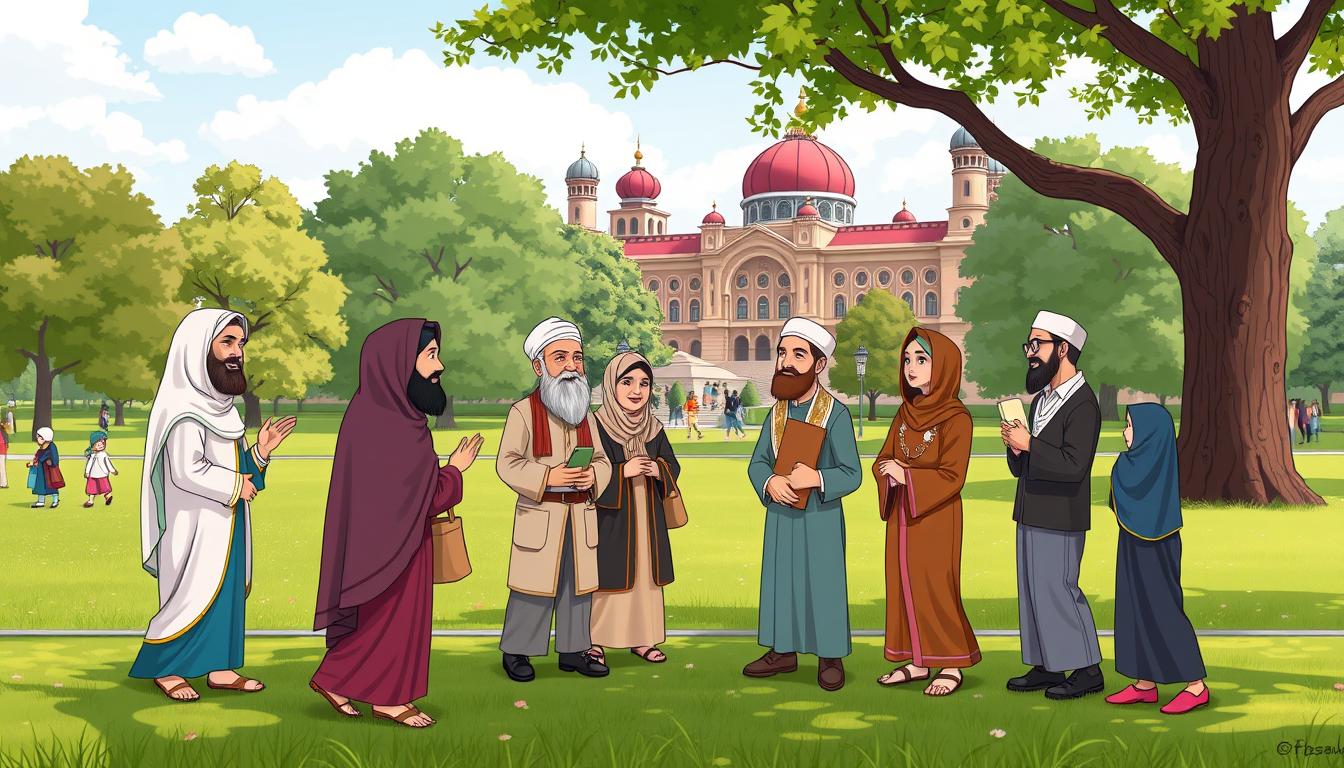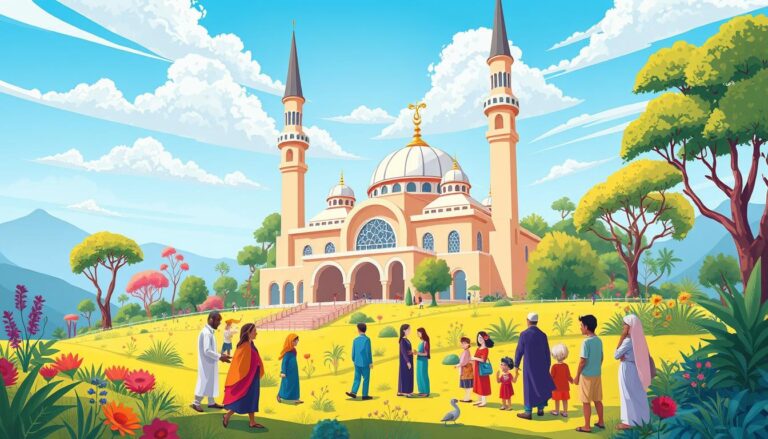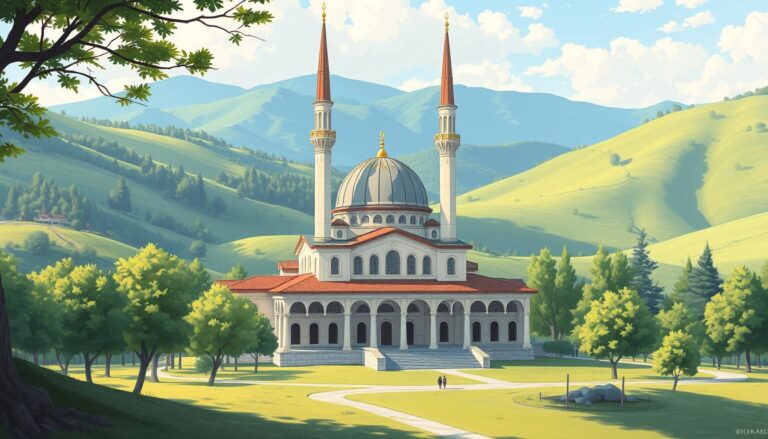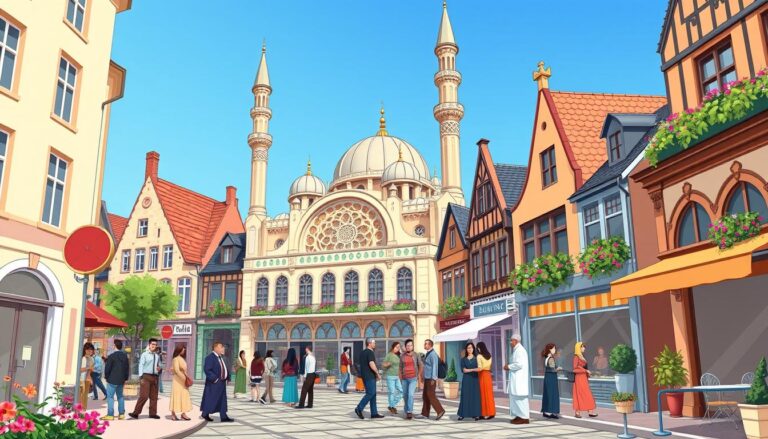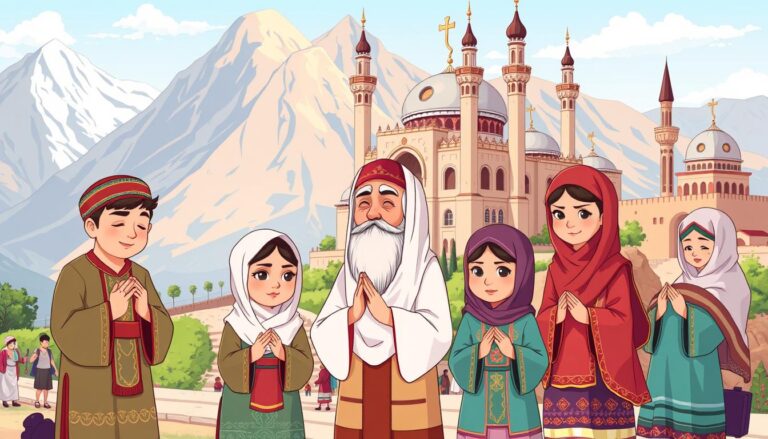Islam in Belarus
According to the 2009 census, there were approximately 20,000 Muslims in Belarus, accounting for just 0.2% of the country’s total population. However, current estimates suggest the Muslim community in Belarus has grown significantly, with mass media reports indicating a range of 80,000 to 100,000 Muslims, and the Mufti Shabanovich citing a figure of around 120,000 as of 2009. This remarkable growth has transformed the Islamic presence in Belarus, making it a topic of increasing importance and interest.
Key Takeaways
- The Muslim population in Belarus has grown significantly in recent years, with estimates ranging from 80,000 to 120,000 Muslims.
- Islam has a rich history in Belarus, with a continuous presence dating back to the 14th century.
- The Lipka Tatars, who settled in the Polish–Lithuanian Commonwealth, have played a central role in the development of Islamic communities in Belarus.
- During the Soviet era, many Muslims left Belarus, but the present-day Belarusian Muslim community includes both remaining Lipka Tatars and recent immigrants.
- The Belarusian government recognizes the legal equality of all religions, including Islam, under the 1992 Law on Freedom of Conscience and Religious Organisations.
Origins and Early History of Islam in Belarus
The history of Islam in Belarus dates back to the 14th century, when the Grand Duchy of Lithuania invited Tatar Muslims from the Golden Horde to assist in protecting their borders. These Tatars, later known as the Lipka Tatars, soon settled in Lithuania and neighboring Poland, and by the end of the 16th century, an estimated 100,000 Tatars were living in the Polish–Lithuanian Commonwealth.
Emergence of Lipka Tatar Communities in the 14th-16th Centuries
The Lipka Tatars were a diverse group, comprising descendants of border guards, voluntary immigrants, and even prisoners of war. They played a crucial role in the defense of the Lithuanian and Polish borders, often serving as skilled military personnel. Over time, the Lipka Tatars became an integral part of the local communities, contributing to the cultural and religious diversity of the region.
Role of Lithuanian Princes in Inviting Tatar Muslims as Border Guards
The decision of the Lithuanian princes to invite Tatar Muslims as border guards was a strategic move, as these skilled warriors could effectively defend the Grand Duchy’s frontiers. The Tatars’ expertise in cavalry and martial arts made them valuable assets in the region’s military and political landscape. This decision not only shaped the early history of Islam in Belarus but also had lasting implications for the cultural and religious make-up of the country.
“The Lipka Tatars played a crucial role in the defense of the Lithuanian and Polish borders, often serving as skilled military personnel.”
The history of Islam in Belarus is deeply intertwined with the Lipka Tatars and their role as Muslim border guards in the Grand Duchy of Lithuania. This unique historical legacy continues to influence the contemporary Muslim communities in Belarus and their place within the country’s diverse cultural landscape.
Islam in Belarus During the Soviet Era
During the tumultuous periods of the Russian Civil War and the Polish–Soviet War, Muslim leaders in Belarus played a crucial role in protecting Jewish communities from pogroms. However, the subsequent establishment of the Byelorussian Soviet Socialist Republic ushered in a dark era for Islam in the region.
In 1935, the authorities began a systematic closure of mosques, with the mullah of Uzda being deported to Siberia. The mullah and muezzin of Smilavichy were also executed, marking a period of intense Muslim persecution in the USSR. As a result, from 1944 to 1946, many Lipka Tatar religious leaders were forced to flee Belarus for Poland, fearing renewed religious persecution.
“The Byelorussian Soviet Socialist Republic became a hostile environment for the practice of Islam, leading to the closure of mosques and the exile or execution of religious leaders.”
Despite these challenges, the Lipka Tatar communities in Belarus managed to maintain their cultural and religious identity, adapting to the constraints of the Islam in Soviet Belarus era. The resilience and adaptability of these communities would prove crucial in the decades to come as they navigated the complex political landscape of the Soviet Union.
Contemporary Muslim Communities in Belarus
Belarus, a nation situated at the crossroads of Eastern Europe, boasts a diverse religious landscape that includes a vibrant Muslim population. The Muslim communities in Belarus trace their roots back centuries, contributing to the country’s rich cultural tapestry.
Demographics and Distribution of Belarusian Muslims
Today, there are an estimated 100,000 Muslims residing in Belarus, making up a small but significant portion of the country’s population. The largest Muslim group in Belarus are the Belarusian Tatars, who have a long history in the region dating back to the 14th century. Additionally, Belarus is home to 32 other Muslim communities that have migrated to the country over the years.
The distribution of Muslim communities in Belarus is primarily concentrated in the Grodno, Minsk, and Vitebsk regions, where the majority of the country’s Muslim communities in Belarus are located. These communities are predominantly Sunni Muslims, following the Hanafi school of Islamic jurisprudence.
The Muslim population distribution in Belarus is further shaped by the religious affiliations of the broader population. According to a 2016 survey, approximately 53% of the adult population in Belarus identifies with the Belarusian Orthodox Church, while 6% are affiliated with the Roman Catholic Church. The survey also found that 8% of the population considers themselves atheists, and 22% are “uncertain” about their religious beliefs.
“The law in Belarus recognizes the ‘determining role’ of the Belarusian Orthodox Church, Roman Catholicism, Judaism, Islam, and evangelical Lutheranism as the traditional faiths, distinguishing them from newer or older religious groups not considered traditional.”
Despite their small numbers, the Muslim communities in Belarus have made significant contributions to the country’s cultural and religious landscape, preserving their traditions and adapting to the Slavic context in which they reside.
The Belarusian Muslim Religious Community
The Muslim religious community in Belarus has a rich and vibrant history, with its roots tracing back to the 14th-16th centuries. In 1994, the First All-Belarusian Congress of Muslims was held, which led to the establishment of the Muslim Religious Community of the Republic of Belarus. This organization has played a pivotal role in preserving and promoting the Muslim faith within the country.
From 1994 to 2005, the community was led by Ismail Alieksandrovič, and since 2005, it has been headed by Abu-Biekir Šabanovič. Currently, there are 30 registered religious organizations and 25 religious communities within the Belarusian Muslim religious landscape, with 24 being Sunni and one being Shia.
The Belarusian Muslim community has faced significant challenges in recent years, particularly with the introduction of the new Law on religion in Belarus. The law, signed in December 2023, requires all registered religious communities to seek re-registration between July 2024 and July 2025. Failure to gain re-registration will render religious communities illegal, subjecting them to potential criminal or administrative punishment.
The new Law imposes stringent registration restrictions and conditions on religious organizations, including the necessity for small religious communities to have 20 adult founders for registration. This poses a significant obstacle for the smaller Muslim communities, especially those in rural areas with fewer members.
“The new Law continues to require state registration for religious communities, bans unregistered religious organizations, and intensifies monitoring and inspection of religious communities.”
Despite these challenges, the Belarusian Muslim religious community remains committed to preserving its rich cultural heritage and continuing to serve the spiritual needs of its followers. As the country navigates the changing religious landscape, it will be crucial for the Muslim community to adapt and find ways to thrive within the new legal framework.
Major Mosques and Islamic Architectural Landmarks
Belarus boasts a rich Islamic architectural heritage, with several mosques and landmarks that showcase the country’s unique blend of Slavic and Muslim influences. The first mosques in Belarus emerged during the 14th and 15th centuries, and today, the country is home to 7 functional mosques located in Smilavichy, Iwye, Slonim, Navahrudak, Minsk, Kletsk, and Vidzy.
Wooden Mosque Architecture: The Ivye Mosque
One of the most significant Islamic architectural landmarks in Belarus is the Ivye Mosque, built in the 19th century. The Ivye Mosque is considered a monument of Belarusian wooden mosque architecture, a unique style that has evolved over centuries. In 1997, a ceremony was held to mark the 600th anniversary of the settlement of Tatars in Belarus, with the opening of a mosque in Navahrudak, further highlighting the enduring Islamic presence in the country.
“The Ivye Mosque, built in the 19th century, is considered a monument of Belarusian wooden mosque architecture, a unique style that has evolved over centuries.”
The architectural design of mosques in Belarus, as in other parts of the world, typically includes features such as a large dome, four minarets at each corner, and a courtyard. These elements not only serve functional purposes but also contribute to the aesthetic beauty and cultural significance of these structures.
The enduring presence of Mosques in Belarus and the country’s Islamic architectural landmarks are a testament to the rich and diverse cultural heritage that has shaped the nation over the centuries.
Islamic Culture and Traditions in Belarus
The Lipka Tatars, an ethnic Tatar minority in Belarus, have maintained their Islamic culture and traditions despite losing their native language and adopting Belarusian, Russian, and Polish. In their religious practices, the Lipka Tatars continue to use the Arabic language, which holds a significant place in their cultural heritage.
Historically, the Belarusian Muslims developed their own unique writing system known as the Belarusian Arabic alphabet, which allowed them to write the Belarusian language using the Arabic script. However, this practice has largely fallen out of use in modern times, with the Latin and Cyrillic scripts now more commonly used.
- Approximately 4% of the Belarusian population identifies with Eastern religious groups, including Muslims, Hare Krishnas, and Baha’is.
- There are 24 registered Sunni and 1 Shia Muslim religious communities in Belarus, making up a small but significant presence in the country’s diverse religious landscape.
- The Lipka Tatar community has maintained its Islamic identity, traditions, and religious practices, despite cultural and linguistic assimilation over the centuries.
The Islamic culture and traditions of the Lipka Tatars in Belarus have survived through the centuries, serving as a testament to the resilience and adaptability of this unique minority group within the broader Belarusian society.
“The Lipka Tatars have managed to preserve their Islamic identity and traditions despite the challenges of living in a predominantly Slavic and Christian environment.”
Islam in Belarus: Adapting to a Slavic Context
The integration of Islam in Belarus has been a fascinating cultural journey, marked by the assimilation of the Lipka Tatar community into the broader Belarusian society. Over the centuries, these Tatar Muslims have undergone significant linguistic and social integration, forging deep connections with the Belarusian, Polish, Lithuanian, and Russian populations through interethnic marriages.
While the Lipka Tatars no longer speak their native Tatar language, they have steadfastly maintained their religious practices, conducting their devotions in the Arabic language. This linguistic assimilation has not diminished the Tatars’ commitment to their Islamic faith, which remains a core part of their cultural identity within the Slavic context of Belarus.
Interethnic Marriages and Language Assimilation
The Lipka Tatar community in Belarus has embraced the notion of cultural integration, with interethnic marriages becoming increasingly common. These unions have fostered a blending of traditions and the adoption of the Belarusian language by the Tatar population, further strengthening the bonds between the two communities.
- The Lipka Tatars have integrated seamlessly into Belarusian society, while preserving their Islamic faith and traditions.
- Interethnic marriages have played a significant role in the assimilation process, leading to the widespread use of the Belarusian language among the Tatar population.
- Despite the linguistic integration, the Lipka Tatars have remained steadfast in their religious practices, conducting their Islamic rituals and observances in the Arabic language.
The story of the Lipka Tatars in Belarus serves as a testament to the resilience and adaptability of the Muslim faith, as it continues to thrive within the Slavic context, embracing the local culture while maintaining its distinctive religious identity.
Challenges and Opportunities for Muslim Integration
The Belarusian Muslim community has faced some challenges in asserting its identity within the predominantly Orthodox and Catholic religious landscape of the country. The low usage of the Belarusian language in everyday life and the cultural predominance of Russians and Poles in their respective churches have made it difficult for Belarusian Muslims to fully integrate. However, the 1991 declaration of Belarus’s independence and the 1990 law making Belarusian an official language have generated a new attitude toward the religious institutions, with some religiously uncommitted young people turning to the Uniate (Greek Catholic) Church.
Despite these challenges, there are also opportunities for Muslim integration in Belarus. The country’s long history of religious tolerance and diverse cultural heritage provide a foundation for embracing the Muslim community. The growing interest in Belarusian language and identity among the younger generation may also create more space for the Muslim community to find its place within the national fabric.
Additionally, efforts to promote interfaith dialogue and understanding can help bridge the gap between the Muslim minority and the predominantly Christian majority in Belarus. By fostering mutual respect and cooperation, the country can harness the rich diversity of its religious communities, including the Belarusian Muslims, to strengthen its social cohesion and cultural resilience.
“The key to successful integration is not the assimilation of minority groups, but the creation of an inclusive society that values and celebrates diversity.”
As Belarus continues to navigate its path as an independent nation, the integration of its Muslim community presents both challenges and opportunities that will shape the country’s future social and religious landscape.
Islamic Education and Scholarly Initiatives in Belarus
In the post-Soviet era, there have been concerted efforts to revive Islamic studies and Arabic language learning in Belarus. The Muslim Religious Community of the Republic of Belarus has focused on building a mosque in the capital city of Minsk and renovating existing mosques throughout the country. These initiatives aim to strengthen the Islamic presence and educational opportunities within the Belarusian Muslim community.
The Muslim community in Belarus has faced challenges in the past, including restrictions on religious conversion and the construction of mosques. However, the post-Soviet period has seen a gradual re-Islamization, with the Muslim population estimated to be around 20,000. The community is working to preserve its cultural heritage and pass on its traditions to the younger generation.
Efforts to Revive Islamic Studies and Arabic Language Learning
One of the key focuses of the Muslim Religious Community of the Republic of Belarus is to revive Islamic education in Belarus and promote the Arabic language learning in Belarus. This involves maintaining and renovating existing mosques, which serve as important hubs for religious education and community gatherings.
- The community has been actively involved in preserving and restoring the Ivye Mosque, a historic wooden mosque that showcases the unique architectural style of Belarusian Islamic architecture.
- Alongside these efforts, the Muslim community is working to provide educational opportunities for young Belarusian Muslims, offering courses in Islamic studies and Arabic language.
- These initiatives aim to ensure the continued transmission of Islamic knowledge and cultural traditions within the Belarusian Muslim community, fostering a sense of identity and belonging.
“The preservation of our Islamic heritage and the promotion of religious education are crucial for the future of our community in Belarus,” said Imam Abdulah Shahab, a leader within the Muslim Religious Community of the Republic of Belarus.
As Belarus navigates its post-Soviet era, the Muslim community’s efforts to revive Islamic education in Belarus and Arabic language learning in Belarus are crucial in maintaining the country’s diverse religious and cultural landscape.
The Future of Islam in Belarus
As Belarus continues to navigate its religious and cultural landscape in the post-Soviet era, the Future of Islam in Belarus and the Outlook for Islam in Belarus remain topics of growing interest. The Belarusian Muslim community, though small, has shown remarkable resilience and a steadfast commitment to preserving its Islamic heritage.
With ongoing efforts to revive Islamic education and maintain the country’s religious infrastructure, the role of Islam in Belarusian society is likely to evolve. This evolution will involve balancing the challenges of integration with the opportunities for greater visibility and meaningful participation in Belarus’ diverse religious landscape.
According to recent data, the Muslim population in Belarus is estimated at around 20,000 individuals, representing a small but significant part of the country’s overall religious demography. As the Belarusian government continues to navigate the delicate balance between religious freedom and state control, the future of Islam in the country will be shaped by the interplay of these forces.
Despite the challenges, the Belarusian Muslim community remains committed to maintaining its cultural and religious identity. The Islamic Association of Belarus, for instance, is actively working to build a new mosque in Minsk and renovate existing religious infrastructure, such as the mosque in Smilovichi. These efforts underscore the community’s determination to ensure the continued presence of Islam in Belarus.
As the Future of Islam in Belarus unfolds, the Outlook for Islam in Belarus points to a future where the Belarusian Muslim community may find increased opportunities for growth, integration, and recognition within the country’s pluralistic religious framework. With continued resilience and adaptability, Islam in Belarus is poised to play an evolving role in shaping the nation’s cultural and spiritual landscape.
“The future of Islam in Belarus lies in the hands of the Belarusian Muslim community, who are committed to preserving their heritage while navigating the challenges of integration and adapting to the country’s diverse religious landscape.”
Conclusion: Appreciating the Diverse Islamic Heritage of Belarus
Belarus, with its unique position between the influences of Western and Eastern Europe, has a rich and diverse Islamic heritage that has endured through centuries of political and social change. From the Lipka Tatar communities that have maintained their traditions to the contemporary Muslim population, Islam has played a significant role in the country’s history and cultural fabric.
The Diverse Islamic heritage of Belarus is a testament to the resilience and adaptability of the faith, as it has seamlessly integrated into the Slavic context. The study’s findings on the impact of religiosity, secularism, and trust in institutions on views regarding religious freedom provide valuable insights into the nuances of this dynamic relationship.
As Belarus continues to evolve, the Importance of Islam in Belarus will only grow. Recognizing and appreciating the contributions of its Muslim communities will be crucial in fostering a more inclusive and pluralistic society, one that celebrates the rich tapestry of cultures that make up this unique nation.
Source Links
- No title found
- Religion in Belarus | Official Internet Portal of the President of the Republic of Belarus
- History of Muslims in Ukraine, Belarus and Russia
- Muhammad and the Origin of Islam in the Byzantine-Slavic Literary Context | Columbia University Press
- Islam in Belarus
- Religion in Belarus
- The mosque
- 2023 Report on International Religious Freedom: Belarus
- BELARUS: Repressive new Religion Law imposes compulsory re-registration
- Belarus – United States Department of State
- Islamic art: characteristics, works, architecture and mosaics
- Sharjah Mosque Project: A Modern Islamic Architectural Masterpiece
- National Profiles | World Religion
- Religion in Belarus: no conscience, no freedom – Index on Censorship
- Freedom of religion in Belarus
- Project MUSE – A Brief History of Islam in Europe
- Islam in Europe
- Muslims in Europe: Promoting Integration and Countering Extremism
- Religious Organizations in Belarus during Protests against the Regime of Aleksandr Lukashenko
- MUSLIM SOCIETY, POLITICS AND ISLAMIC EDUCATION IN THE FORMER RUSSIAN EMPIRE: THE 20 TH CENTURY AND BEYOND, edited by Elmira Akhmetova, Elmira Muratova, and Gapur Oziev
- BELARUS 2021 INTERNATIONAL RELIGIOUS FREEDOM REPORT
- Belarus – United States Department of State
- Belarus News and Analysis | The tragedy of Islam in Belarus
- Views on Religious Freedom among Young People in Belarus and Norway: Similarities and Contrasts
- Cultural Heritage Protection in Islamic Tradition | International Journal of Cultural Property | Cambridge Core

